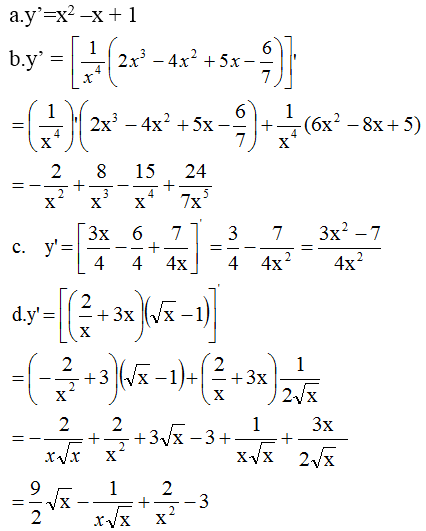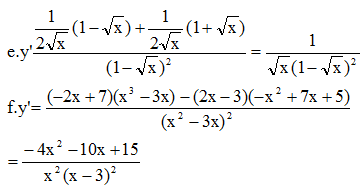
Hãy nhập câu hỏi của bạn vào đây, nếu là tài khoản VIP, bạn sẽ được ưu tiên trả lời.


\(\lim\limits_{x\rightarrow1}\dfrac{x^3-3x+2}{x^4-4x+3}=\lim\limits_{x\rightarrow1}\dfrac{\left(x+2\right)\left(x-1\right)^2}{\left(x^2+2x+3\right)\left(x-1\right)^2}=\lim\limits_{x\rightarrow1}\dfrac{x+2}{x^2+2x+3}=\dfrac{1}{2}\)
\(\lim\limits_{x\rightarrow2^-}\dfrac{x^3+x^2-4x-4}{x^2-4x+4}=\lim\limits_{x\rightarrow2^-}\dfrac{\left(x-2\right)\left(x^2+3x+2\right)}{\left(x-2\right)^2}=\lim\limits_{x\rightarrow2^-}\dfrac{x^2+3x+2}{x-2}=-\infty\)
\(\lim\limits_{x\rightarrow2}\dfrac{\left(x^2-x-2\right)^{20}}{\left(x^3-12x+16\right)^{10}}=\lim\limits_{x\rightarrow2}\dfrac{\left(x+1\right)^{20}\left(x-2\right)^{20}}{\left(x+4\right)^{10}\left(x-2\right)^{20}}=\lim\limits_{x\rightarrow2}\dfrac{\left(x+1\right)^{20}}{\left(x+4\right)^{10}}=\dfrac{3^{10}}{2^{10}}\)
\(\lim\limits_{x\rightarrow0^-}\dfrac{4x^2+5x}{x^2}=\lim\limits_{x\rightarrow0^-}\dfrac{4x+5}{x}=-\infty\)
\(\lim\limits_{x\rightarrow-1}\dfrac{\sqrt{x+2}-1}{\sqrt{x+5}-2}=\lim\limits_{x\rightarrow-1}\dfrac{\left(x+1\right)\left(\sqrt{x+5}+2\right)}{\left(x+1\right)\left(\sqrt{x+2}+1\right)}=\lim\limits_{x\rightarrow-1}\dfrac{\sqrt{x+5}+2}{\sqrt{x+2}+1}=2\)

ta có (f(x)-20)/(x-2)=10
===>f(x)=10x
thay f(x)=10x vào A và thay
x=2+0,000000001 ta được giới hạn của A= -331259694,9
cái chỗ F(x) =10x đó ,đâu có là sao vậy ạ , tại có thể 10 đó là g(2)=10

Chứng minh các biểu thức đã cho không phụ thuộc vào x.
Từ đó suy ra f'(x)=0
a) f(x)=1⇒f′(x)=0f(x)=1⇒f′(x)=0 ;
b) f(x)=1⇒f′(x)=0f(x)=1⇒f′(x)=0 ;
c) f(x)=\(\frac{1}{4}\)(\(\sqrt{2}\)-\(\sqrt{6}\))=>f'(x)=0
d,f(x)=\(\frac{3}{2}\)=>f'(x)=0




Đề bài thiếu 1 vế rồi bạn